A first century BC document from Italy, preserved, but obscured, by the ashes of Mount Vesuvius, has been brought to life, says S.Ananthanarayanan.
The great eruption of Mount Vesuvius, in 79 AD, destroyedcopy many cities in the Campania region in southern Italy, especially Pompeii and Herculaneum. But the 100 foot thick layer of volcanic material that covered the cities has also captured living habitations, and their Greco-Roman culture, for future generations of historians to study.
After the buried cities were first discovered, while digging the ground for wells or by treasure seekers, Charles III, the Bourbon prince who became king of Naples in 1734, ordered what has turned out as the first systematic archeological excavation. The project was entrusted to the Spaniard, Rocque Alcubierre, who is said to have been insensitive to the value of what he was uncovering, but his assistant, Carl Weber, a Swiss engineer, made sketches and drawings of the ancient city of Herculaneum and is credited with the discovery of the magnificent Villa dei Papiri, the seaside mansion thought to have been built by Julius Caesar's father-in-law. Along with the architectural marvels of the palace, there was discovered also a small room, thought to be a library, ranged with shelves filled with hundreds of handwritten rolls of papyrus – from which the mansion has got its name. This rich collection of philosophical texts is now mainly stored in the Officina dei Papiri in the National Library of Naples, but six rolls had been gifted in 1802 to Napoleon Bonaparte, then First Consul of France, and these are in the collection at the Institut de France, in Paris.
But although the rolls of papyrus are preserved, they have been completely carbonized by the hot gases, steam and mud which swept over the town. The result is that the rolls are fused and brittle and difficult to separate. And as the black ink that was used was carbon-based, derived from smoke residue, the writing can scarcely be distinguished from the carbonized papyrus sub-stratum. Father Antonio Piaggio, a conservator from the Vatican, developed a procedure to open out at least some of the rolls. This has had limited results and another method recently tried, which involves separating the papyrus into small pieces, has also been abandoned, to save the texts till an effective method is found.
But there has been some progress in making out the writing in some of the rolls that have been opened out. The methods used include binocular microscopes and digital photography, with arrangements to isolate frequencies of light that belong to a narrow band in the near-infrared. But these methods can be used only where the rolls have been opened out, not with the rolled up texts, as the writing overlaps and near-infrared light cannot penetrate the material. Usual X Ray methods do not work because the base and the writing are equally transparent and throw no shadow. For the same reason, even the versatile technique of the CT scan – computed tomography, where a computer builds up a 3D image, cannot be used. Even X Ray fluorescence, which has helped imaging of writing covered with chemicals, or mould, by causing the writing portion to glow, is of no use to find carbon on carbon!
But a new X Ray method, which relies on the slightly longer time that X Rays take to traverse the writing on the papyrus has been devised, and this has shown promising results. Vito Mocella, Emmanuel Brun, Claudio Ferrero and Daniel Delattre, from the CNR-IMM-Istituto per la Microelettronica e Microsistemi-Unita` di Napoli, the European Synchrotron at Grenoble, Ludwig-Maximilian-Universitat in Munich and the CNRS-IRHT-Institut de Recherche et d’Histoire des Textes, Paris, report in the journal, Nature Communications that X Ray phase contrast tomography (XPCT), as the method is called, is able to reveal Greek letters inside the precious papyri without unrolling them. “This attempt opens up new opportunities to read many Herculaneum papyri, which are still rolled up, thus enhancing our knowledge of ancient Greek literature and philosophy”, they say.
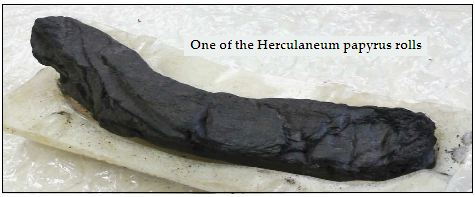
Papyrus, the most common material used for books and documents in ancient times, was constructed from stalks of the papyrus plant. Strips, about 40 cm long, which had been soaked in water, were first placed next to each other, edges slightly overlapping. Another set of strips was then placed on the first lot, but length-wise. The mat of papyrus fibre was then hammered, so that the layers were mashed into a single sheet. The sheet was then dried under pressure, and finally polished, to yield a smooth writing surface. The sheet could also be built on as a longer roll, for longer documents. Writing was first on the side where the fibres were along the length, or the recto, and then on the other side, or the verso. In dry climates, as in Egypt, papyrus was stable and could last a long time. But this is not true of more humid places, as the Mediterranean, and most papyri found in Europe have deteriorated. The papyri of Herculaneum were saved from deterioration by the covering of volcanic matter, which formed into a kind of soft rock, but the pressures compressed the scroll and deformed its internal spiral form, with layers chaotically entangled.
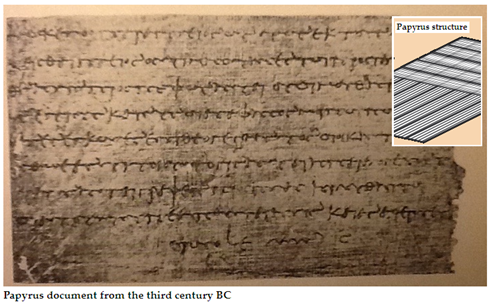
While there is hence little chance of getting an unobstructed view of any surface of single papyrus sheets, in the XPCT method, different parts of the X Ray beam which passes through the complete roll emerge after having passed through different thickness of carbon. As X Ray waves move slower through carbon than through air, some parts of the X Ray beam, which have gone through places where there was writing, emerge tiny instants later than other parts, which did not pass through writing or have passed through less writing. Places where the X Ray beam is detected, after passing through the scroll, would hence receive waves at different stages of their wave motion, or different phases, from different parts of the scroll, and these would interfere, getting weaker or cancelling out when the phases are opposed. Detecting the strength of the transmitted X Ray beam, while the scroll is rotated, to scan different paths, would then collect a mass of information. Complex computer processing could then discern individual shapes of the thicker carbon, at the same depth, and hence an indication of shapes and writing.
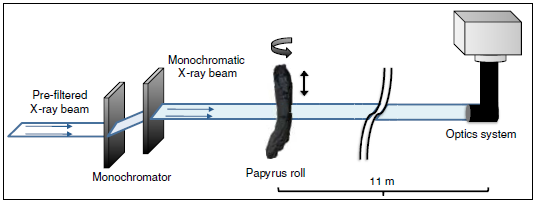
The reconstruction has been challenging, the authors of the paper say, but they have succeeded, nevertheless, in forming images of some of the letters in the two rolls that are preserved in Paris. One of the rolls has been partly opened out while the other is still rolled up. The first trial, in a piece of the opened out document, reads one word as :
(pi iota pi tau omicron iota epsilon), which could mean ‘would fall’, and another word in the next line as:
(epsilon iota pi omicron iota), meaning, ‘would say’. The unopened roll was naturally more challenging, and here, just a few letters in sequence have been imaged. But from different sections, twenty four Greek letters have been discerned, the fact that important Greek text mostly used capital letter being a definite help.
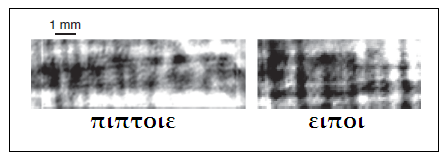
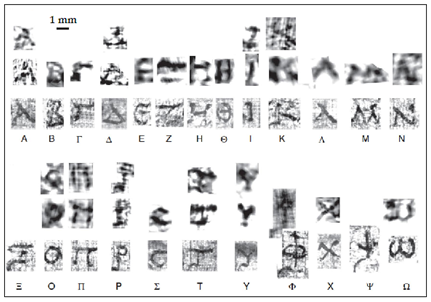
But the fact that XPCT is able to read inside carbonized papyrus rolls holds out the promise that whole documents, even other texts, or scrolls yet to be discovered, may someday be reconstructed. The suggestions, from study using traditional methods, of texts already opened out, indicate that the bookshelves of Villa dei Papiri may be the personal library of the Epicurean philosopher, Philodemus (110-35 BC), who is known for versatile scholarship. Being able to resurrect his works would rekindle the excitement there was when the library was first discovered.
But the fact that XPCT is able to read inside carbonized papyrus rolls holds out the promise that whole documents, even other texts, or scrolls yet to be discovered, may someday be reconstructed. The suggestions, from study using traditional methods, of texts already opened out, indicate that the bookshelves of Villa dei Papiri may be the personal library of the Epicurean philosopher, Philodemus (110-35 BC), who is known for versatile scholarship. Being able to resurrect his works would rekindle the excitement there was when the library was first discovered.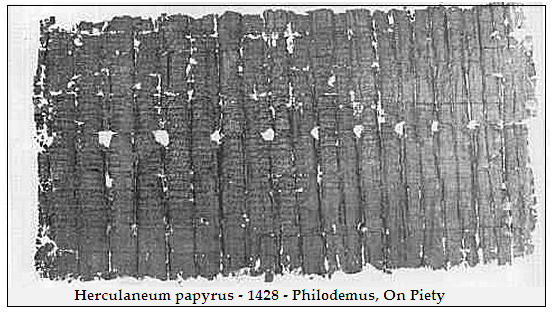
------------------------------------------------------------------------------------------